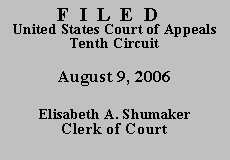

| UNITED STATES OF AMERICA, | No. 05-1314
(D.C. No. 05-CR-15) (D. Colo.) |
In Anders, the Supreme Court concluded that if appointed counsel finds a defendant's case
to be wholly frivolous, after a conscientious examination of it, he should so advise the court and request permission to withdraw. . . . A copy of counsel's brief should be furnished the indigent and time allowed him to raise any points that he chooses; the court--not counsel--then proceeds, after a full examination of all the proceedings, to decide whether the case is wholly frivolous. If it so finds it may grant counsel's request to withdraw and dismiss the appeal . . . .
386 U.S. at 744. We therefore both evaluate the arguments made in counsel's brief and conduct an independent evaluation of the record in deciding this appeal.(1)
Based on the Supreme Court's decision in United States v. Booker, 543 U.S. 220 (2005), we review Mr. Herrera-Vasquez's sentence for reasonableness. United States v. Kristl, 437 F.3d 1050, 1053 (10th Cir. 2006). "Reasonableness review is guided by the factors set forth in 18 U.S.C. § 3553(a)," including the Sentencing Guidelines. Id. In fact, "a sentence that is properly calculated under the Guidelines is entitled to a rebuttable presumption of reasonableness." Id. at 1054.
After adjustment for acceptance of responsibility, the district court calculated Mr. Herrera-Vasquez's total offense level under the advisory Sentencing Guidelines to be 29. When combined with his criminal history category of I, this corresponded to a Guideline range of 87 to 108 months imprisonment. See U.S.S.G. § 5A.(2)
Pursuant to 21 U.S.C. §§ 841(b)(1)(B) and 846, Mr. Herrera-Vasquez's conviction requires a term of supervised release of at least four years.(3) The Sentencing Guidelines further advise that the term of supervised release should be at least four and at most five years. See U.S.S.G. § 5D1.2(a)(1) (providing that a person convicted of a Class B felony should be sentenced to "not more than five years" of supervised release); 18 U.S.C. § 3559(a) (providing that an offense with a maximum prison term of 25 years or more is a Class B felony); 21 U.S.C. §§ 841(b)(1)(B) & 846 (setting a maximum prison term of 40 years for Mr. Herrera-Vasquez's offense).
In the district court's Statement of Reasons for Mr. Herrera-Vasquez's sentence, the court asserted that it had considered the factors listed in 18 U.S.C. § 3553(a), including: the Sentencing Guidelines, "the nature and circumstances of the offense," "the history and characteristics of the defendant," and the goal of "avoiding unwarranted sentence disparities among defendants with similar records who have been found guilty of similar conduct." Ultimately, the court determined that based on "the[se] considerations . . . , especially the need to avoid unwarranted disparities among defendants . . . , the court will impose a sentence within the recommended guideline range." The court found that "a term of incarceration is appropriate" and that a prison term of 87 months, the low end of the Guideline range, "is sufficient, but not greater than necessary, to achieve the statutory purposes of such a sentence." As for supervised release, the district court found "that a term of supervised release following imprisonment is statutorily mandated" and that a term of five years, the high end of the Guideline range, is "reasonably related to -- and involves no greater deprivation of liberty than is reasonably necessary to achieve -- the statutory purposes of this component of the sentence."
Mr. Herrera-Vasquez's sentence was therefore within the Guideline range: the prison term at the low end and the term of supervised release at the high end. Both aspects of the sentence are therefore presumptively reasonable. Kristl, 437 F.3d at 1054. Our review of the record has disclosed no evidence to suggest that the presumption should be rebutted in this case. The district court properly considered the factors in § 3553(a), and our independent evaluation of those factors does not lead us to think that the sentence imposed was unreasonable. We therefore agree with counsel that this appeal presents no meritorious issues, allow appointed counsel to withdraw, and DISMISS the appeal.
ENTERED FOR THE COURT
David M. Ebel
Circuit Judge
*.After examining appellant's brief and the appellate record, this panel has determined unanimously that oral argument would not materially assist the determination of this appeal. See Fed. R. App. P. 34(a)(2) and 10th Cir. R. 34.1(G). The case is therefore ordered submitted without oral argument. This Order and Judgment is not binding precedent, except under the doctrines of law of the case, res judicata, and collateral estoppel. The court generally disfavors the citation of orders and judgments; nevertheless, an order and judgment may be cited under the terms and conditions of 10th Cir. R. 36.3.
1.Mr. Herrera-Vasquez has not filed a brief of his own raising any additional points for us to consider, and the government has deferred to counsel's Anders brief.
2.Our review of the record has disclosed no reason to think that either the offense level, the criminal history category, or the sentencing range was improperly calculated.
3.21 U.S.C. § 841(b)(1)(B) provides that a sentence for distributing or possessing with intent to distribute fifty grams or more of a substance containing methamphetamine "shall . . . include a term of supervised release of at least 4 years in addition to [the] term of imprisonment." Section 846 provides that "[a]ny person who . . . conspires to commit any offense defined in [§§ 801-904] shall be subject to the same penalties as those prescribed for the offense." See also U.S.S.G. § 5D1.2(c).